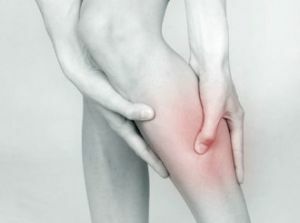 At present, many people face such an unpleasant problem as pain in the veins. The emergence of venous pain can cause many causes - fatigue, severe stress, as well as various phlebological diseases.
At present, many people face such an unpleasant problem as pain in the veins. The emergence of venous pain can cause many causes - fatigue, severe stress, as well as various phlebological diseases.
But the main and main reason why there is pain in the veins on the legs is a violation of the circulation. It is the wrong flow of blood that ultimately causes inflammatory processes and unpleasant sensations.
Contents
- Caution, varicose veins and( s) with it!
- Do not panic ahead of time
 What does it all start with - varicose
What does it all start with - varicose - Thrombophlebitis - heaviness, pain and fear
- Thrombosis of lower extremity veins
- Postphlebitic syndrome
- Typically female problems
- Small pelvis varicose
- Veins during pregnancy
- Accompanying sensations
- What can be done inhome conditions
- Diagnostics and medical care
- Medication therapy
- Surgical intervention
- Physiotherapy
- And the veins do not remind you anymore!
Caution, varicose veins and( s) with it!
The occurrence of pain in the veins is often not only a sign of fatigue, but also the first sign of the appearance of varicose veins, as well as thrombosis, phlebitis. Usually this is due to circulatory disorders, which requires immediate treatment.
Often, the pain in the veins that are observed on the legs, especially on the legs, under the knees and in the calf muscles, is associated with a phenomenon such as venous insufficiency. As a result, this leads to the appearance of various phlebological pathologies.
Do not panic ahead of time
Reasons for the appearance of pain in the veins, which are not associated with phlebological diseases:
- constant load, for example, long time on the legs;
- fatigue;

- physical overvoltage;
- long time sitting in a sitting position;
- various changes in the hormonal system;
- reception of hormonal contraceptives;
- smoking and alcoholism;
- heredity;
- improper power supply;
- injury.
But nevertheless more often the painful discomfort in the venous system causes phlebological diseases.
How it all begins - varicose
With varicose veins, the veins become wide, inflamed and protruding. In appearance they look like twisted cords with a bluish color. In addition, through the skin you can see inflamed vessels, and they look like blue or purple ropes.
During this disease, the elasticity and functionality of the vessels decreases, they become rigid and their structure thickens.
The main symptoms of varicose veins:
- strong swelling of the shins and feet towards the evening;
- observation of constant, aching and severe pain in the veins on the legs or hands, depending on the location;
- the skin in the affected areas acquires a compacted structure, becomes dark and pigmented;
- occurrence of persistent changes in width and length of veins, which causes circulatory disturbance and problems in the functioning of venous valves;
- over time, if left untreated, hard-to-treat ulcers form on the surface;
- further the walls of the affected veins become thin, burst, and bleeding occurs, which can even lead to death;
- can cause convulsions when running forms.
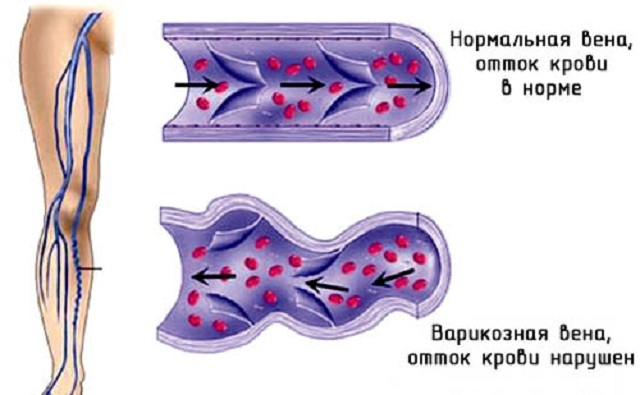
Thrombophlebitis - Severity, Pain and Fear
Thrombophlebitis is the inflammation of the veins, during which a thrombus arises in the place of the lumen of the vessel. This pathology usually appears in patients who already have varicose veins.
The main symptom that accompanies this disease is strong pain in the veins and their subsequent inflammation, they acquire a dense structure and protrude through the skin.
Touching inflamed veins gives rise to severe pain, which is most often seen in the upper part of the shin and under the knee.
Thrombosis of the lower extremities veins
Deep vein thrombosis in the majority of cases initially occurs without a vivid symptomatology. Quite often, this disease occurs in patients with paralysis of the hands or feet, as well as in bedridden patients. 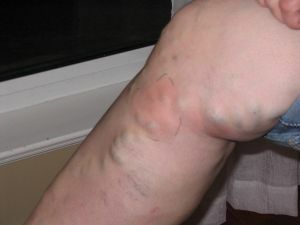
Symptoms of the disease:
- pain in the veins;
- occurrence of bilateral edema of the legs;
- appearance of local hyperthermia;
- often appears blue to the surface of the skin of the legs.
Postphlebitic syndrome
Postphlebitic syndrome is a condition that occurs after a variety of venous pathologies, which is accompanied by a process of restoring veins.
During this condition, resorption or substitution by connective tissue fibers of blood clots is observed. However, the valve flaps are in the affected state and they can no longer function normally.
This condition is accompanied by a strong pain syndrome of veins, as a result of which patients often even limp. In addition, the legs are constantly swelling.
Typically female problems
In women, the causes of pain in the veins are many, mostly phlebologic diseases that are inherent in men, namely:
- varices;
- thrombophlebitis;
- phlebitis;
- Postphlebitic Syndrome.
However, in addition to these diseases, women also have other pathologies and conditions that are accompanied by pain in the field of venous vessels.
Small pelvis varicose
 Occasionally, varicose veins of the small pelvis occur, during which severe pain in the area of inflamed veins also occurs.
Occasionally, varicose veins of the small pelvis occur, during which severe pain in the area of inflamed veins also occurs.
In addition to pain, there is another important symptom - increased pain in the lower abdomen and profuse discharge from the genitals.
Basically, the pains are aching and pulling, sometimes they are given to the groin area.
Veins hurt during pregnancy
Soreness in pregnancy is mainly due to increased severity and strain. Particularly severe pains appear in the second trimester of pregnancy, at this stage many women develop varicose veins of the inguinal region.
In addition to pain, varicose during pregnancy is accompanied by symptoms:
- severe swelling of the legs;
- heaviness in the legs;
- on the surface of the skin of the legs appears subcutaneous veins, as well as the formation of vascular asterisks;
- occurrence of seizures, especially at night;
- severe pain in the legs;
- itching;
- appearance of enlarged veins pigmentation.
Accompanying sensations
Usually the pain in the veins is accompanied by the following symptoms: 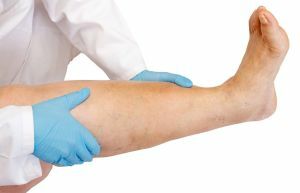
- occurrence of edema in the area in which the pain is observed;
- formation of swelling;
- itching and burning;
- inflammation of the veins, which later protrude above the surface of the skin;
- appearance of spots of blue or violet, as well as vascular asterisks with a burgundy hue;
- feeling of heaviness.
What you can do at home
There are a lot of folk remedies and ways to relieve and relieve pain in the veins, among which it is worth highlighting the most  effective:
effective:
- Treatment with leeches .This method of treatment is used in conjunction with physiotherapy. Leeches during the exhaustion of blood release hirudin, which has a diluting effect. As a result, blood circulation is normalized.
- Application of aromatic oils .On the surface of the skin with the affected areas, you can massage the essential oils - lemon, cypress, orange, mint, lavender.
- For internal reception you can use tinctures from flowers and fruits of chestnut, white acacia, young walnuts .
- For the treatment of varicose disease, you can use aloe vera and apple cider vinegar .To do this, you need to moisten a piece of gauze with vinegar or aloe extract and apply to affected areas 2 times a day.
- Therapeutic foot baths .Every day you need to soar your feet in the water with a decoction of herbs - lemon balm, burdock, birch leaves, nettle, chamomile.
Diagnosis and medical care
At the first signs of discomfort in the veins, you should immediately contact a phlebologist or a vascular surgeon. Then a thorough examination is conducted, aimed at identifying the cause of the pain in the veins. Basically, this problem is caused by phleblo-logical diseases.
In these cases, the doctor prescribes a comprehensive treatment:
- use of drug therapy;
- treatment by surgery;
- physiotherapy.
Drug therapy
During therapy, special anti-varicose drugs are used that exert a tonic effect on the movement of blood in the veins, and also strengthen the venous walls, eliminate puffiness and prevent other dangerous consequences.
The following types of drugs are prescribed:
- Drugs that have a tonic effect on blood circulation in the veins - phlebotonics and venotonicks .Troxevasin and Detralex.
- Anti-inflammatory drugs , which relieve swelling of the lower leg and feet. Indovazin and Diclofenac.
- Anticoagulants are drugs designed to dissolve blood clots, and they prevent the appearance of blood clots. Heparin and its derivatives.
- Blood liquefaction products .Curantil and Lyoton.
Surgical intervention
 Most often in modern vascular surgery, methods of minimally invasive treatment are used. When varicose is prescribed laser coagulation or radiofrequency obliteration. During these operations, the affected vein is sealed on both sides.
Most often in modern vascular surgery, methods of minimally invasive treatment are used. When varicose is prescribed laser coagulation or radiofrequency obliteration. During these operations, the affected vein is sealed on both sides.
Sometimes, varicose veins are treated with a veinectomy. During this operation, the vein is completely removed. This method is considered obsolete, and it is used only in municipal and state medical institutions.
In thrombosis, thromboembolism can be prescribed. This method of treatment is prescribed if there is a risk of pulmonary embolism, gangrene and other serious consequences.
Also, thrombosis can be treated with balloon angioplasty. During this procedure, the lumen of the vessel is restored, which increases the movement of blood inside it.
Physiotherapy
Varicose expansion and other phlebological diseases are prescribed different physiotherapeutic procedures:
- Local darsonvalization .This procedure increases blood circulation and improves lymph flow.
- Impulsive magnetotherapy .During this treatment, edema is swelling, blood flow through the veins is increased, and the muscle fibers of the vein walls are stimulated.
- Application of magnetic field and laser .This complex treatment allows you to quickly remove pain, strengthen the veins, get rid of thrombosis.
And the veins do not remind you anymore!
To prevent diseases of the venous system, which are often accompanied by pain and swelling of the veins, the following recommendations should be fulfilled: 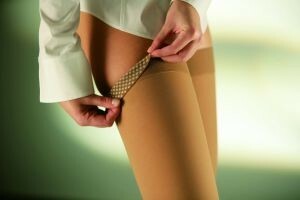
- , women should preferably stop using contraceptives that slow blood flow in the veins;
- if you have to stand for a long time or sit in an uncomfortable position, you need to rest your feet;
- people who have a history of phlebitis, control the load on their legs and provide them with rest;
- for dilution of blood should be taken aspirin;
- every day you need to pamper yourself with a contrast shower;
- wearing compression elastic underwear - pantyhose, stocking, this clothing prevents the appearance of edema, stimulates blood circulation, removes inflammation.
